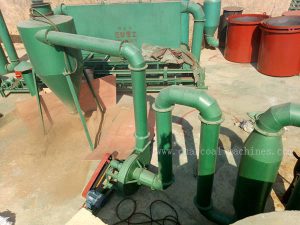Usually combined with crushing operation of materials. The wet material is fed into the feeding drum from the feeding trough through an adjustable quantity feeder, and the feeding drum is rotated to the lower part of the vertical pipe. Air is fed into the preheater by a blower and heated to 80-90 C and then blown into a vertical tube. The velocity in the tube is determined by the size and density of the wet particles, usually 10-20 m/s. The dried particles are carried by intense air flow to the buffer (closed at the upper end) and then fall into the cyclone separator along the landing tube. The dry material is discharged and discharged through the unloading cylinder. Exhaust gas is discharged through the upper end of the exhaust pipe through the bag filter.

The main advantages are:
(1) the hot air is directly contacted with the dried material, and the drying speed is fast and the intensity is high.
(2) the drying time is only 5-7 seconds.
(3) the structure is simple and the floor space is small.
(4) suitable for mass production. The drawback is that more energy is consumed.
Widely used in industry. According to the type of equipment, it can be divided into straight tube air dryer, cyclone air dryer, pulse air dryer and so on.
Airflow dryer working principle
The wet material enters the drying pipe from the screw feeder, and the air is blown in by the blower. After heated by the heater, the wet material is combined with the material to achieve the purpose of drying in the drying pipe. The dried materials are recycled in cyclone dust collector and bag filter.
Airflow dryer use characteristics
Advantages: high drying strength, very short drying time, high thermal efficiency, simple equipment, and great capacity for processing, product quality uniform and reliable.
Application scope
The moisture content of wet material treated is between 10~40%.
